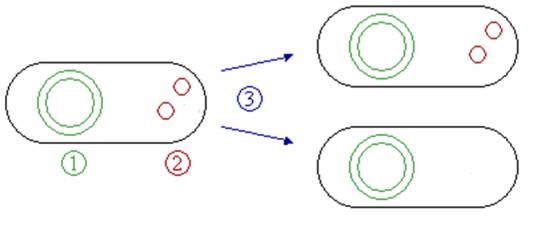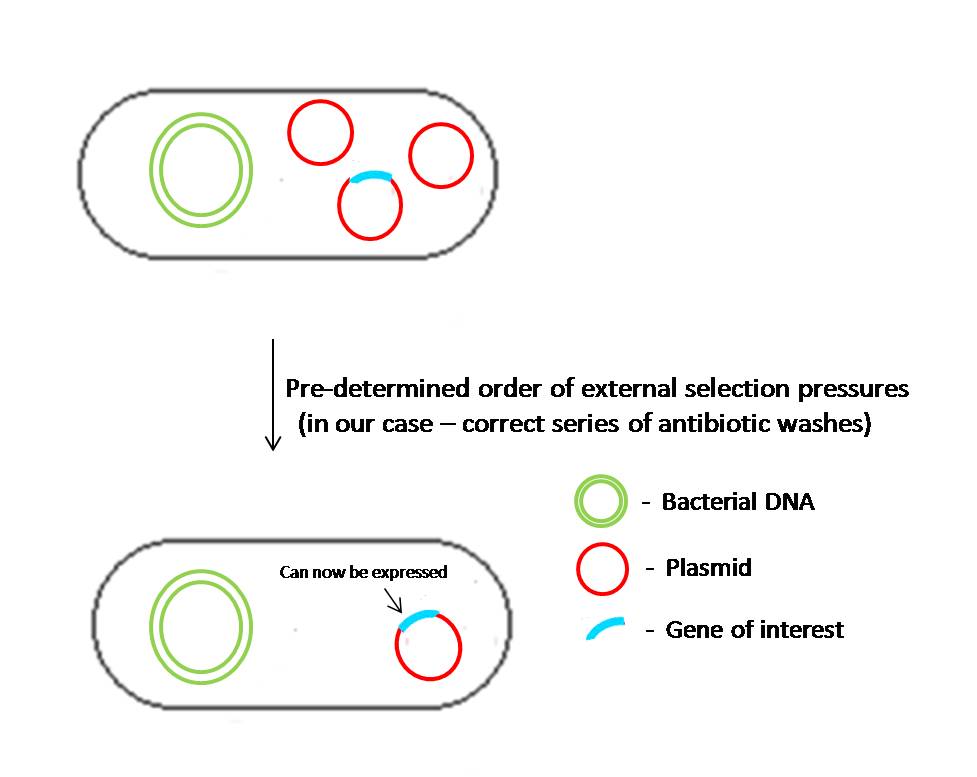Team:IIT Madras/Theory
From 2009.igem.org
Theory
The most important idea behind the working of the lock is plasmid loss due to lack of selection. Any extra-chromosomal genetic material introduced into the cell tends to disappear over the generations, unless it confers a selective survival advantage over the cells that do not possess the plasmid. During the growth of bacteria, plasmid-free variants arise in the initially homogeneous plasmid-bearing cell population basically in two ways. First, each plasmid-bearing cell has a certain probability to give rise to a plasmid-free cell at cell division (this depends on the mechanisms of plasmid distribution between daughter cells, plasmid copy number at the cell division, the presence of multimer resolution loci, etc.).
Fig 2.1: During cell division, rarely all the plasmids segregate into only one of the daughter cells, thus giving rise to plasmid free cells in the population. This event happens independent of what kind of plasmid the cell contains.
Fig 2.2: Cells containing plasmids have a higher metabolic strain of synthesizing the proteins that are encoded by the plasmid, thus they tend to grow slower than the cells without any plasmids. The growth difference is pronounced especially during the exponential phase.
Usually, such probability is very low for natural plasmids (about 10-7) whereas recombinant plasmids (i.e. genetically modified) may segregate with a higher probability (10-3—10-5). Several hypotheses have been put forward to explain this tremendous difference: impaired copy number control, the absence/impairment of the multimer resolution genes and random distribution of plasmid among daughter cells for low copy number plasmids. Second, it was experimentally found that plasmid-bearing cells usually have a lower maximum specific growth rate than their plasmid-free counterparts, and once a plasmid-free cell arises, it competes with its plasmid-bearing counterparts rapidly and ultimately phases it out. Since most recombinant plasmids are not conjugative (not capable of self-transfer to other plasmid-free cells), if a cell has lost a plasmid, there is no way for the cell to acquire it again. Thus, a segregation of plasmids at cell division and the difference in the growth rates of plasmid-free and plasmid bearing subpopulations determine the rate at which plasmids are lost during prolonged cultivation. Here, we use plasmids which can confer resistance to certain antibiotics in the medium and link them up in a certain way so that they repress the expression of the gene of our interest. As the selection pressure is removed, the plasmids which have the repressors for the gene of interest are lost, hence revealing the gene on using the correct series of antibiotic washes.
Fig 2.3: In the initial state, all the cells bear a network of plasmids which can sustain each other under the influence of a particular selection pressure. In this state, the plasmids other than the one containing the gene of interest have repressors for the promoter that expresses the gene of interest in plasmid 1. As the cells are grown in a correct order of varying selection pressures, the cells lose plasmids directionally, thus leading to the expression or "unlocking" of the gene of interest.
 "
"









